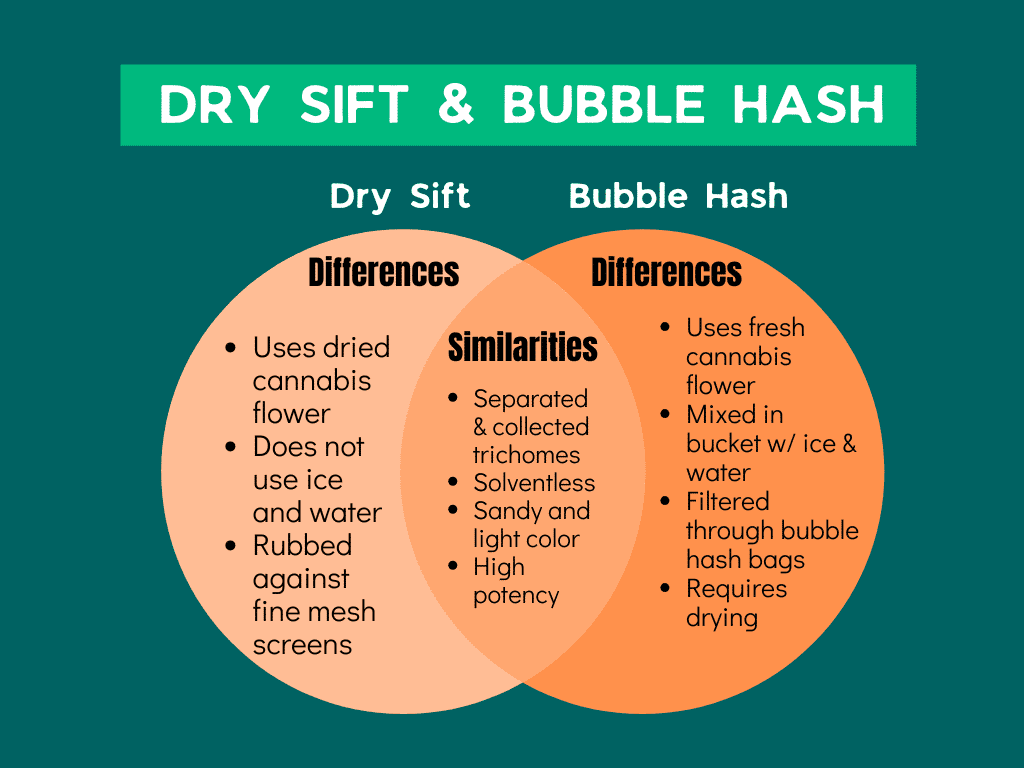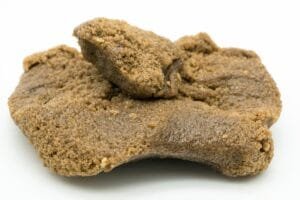Cannabis concentrates are the foundation for offering a wide range of products; among these, solventless extracts stand out. For purity-conscious enthusiasts, two solventless concentrates dry sift and bubble hash hold an advantageous position. Understanding the dry sift vs bubble hash comparison is essential for home processors, commercial operators, and consumers.
In this guide, we explore the processes, benefits, limitations, and ideal applications of these solventless concentrations.
Sections
ToggleWhat Is Dry Sift Hash?

Dry shift is a solventless concentrate produced from the cannabis plant, mechanically separating trichome heads using screens or mesh filters. The extraction process is straightforward, utilizing gravity, agitation, and progressive filtration to isolate cannabinoid-rich resin glands without the use of solvents or complex equipment.
How Dry Sift Is Made
- Preparation: Cannabis material is prepared for extracting dry sift by either drying flowers or fresh-freezing material. This makes trichomes brittle and easier to separate from plant matter.
- Sifting: Dried or frozen cannabis material is gently agitated over stacked screens with progressively finer micron sizes.
- Refinement: The separated trichomes are then further screened to remove remaining plant contamination. For premium-quality dry sift, typically 3-5 sifting stages are required.
Tools Used: For dry sift hash production, simpler tools, including stainless steel or silk screens, sifting boxes, pollen tumblers or automated sifting machines, and collection trays are used.
Pros and Cons of Dry Sift Extraction
Dry sift is a solventless extract that is preferred for its purity, but it’s essential to understand its pros and cons.
Pros:
- The production process is simple, requiring minimal equipment investment. Excellent for small-batch home extraction.
- The solventless approach preserves natural terpene profiles, as no volatile aromatic compounds are destroyed.
- Fast processing that usually completes within hours, rather than the days required for freeze-drying bubble hash
Cons:
- Lower purity as compared to high-grade bubble hash.
- The process is labor-intensive due to multiple physical refinement steps.
- Yield depends heavily on material quality due to the absence of chemical refining processes.
What Is Bubble Hash?

Bubble hash, also known as ice water hash or ice wax, is another solventless extract created by using ice-cold water and agitation to separate trichomes from cannabis plants. It has high purity with full-melt quality. The water-based extraction method yields a high quantity while maintaining purity and potency, eliminating the need for chemical solvents.
How Bubble Hash Is Made
- Preparation: Fresh-frozen or dried cannabis material is put in a vessel with ice and cold water. The near-freezing temperatures make trichomes brittle while keeping them intact. The ice-to-plant material ratio is typically kept at 1:1 to 3:1.
- Agitation: The mixture is then stirred using tools or mechanically agitated for 15-20 minutes. This causes trichome heads to detach from the plant material. The agitation is kept gentle to prevent excessive plant contamination.
- Filtration: The water-trichome mixture is filtered through a series of stacked mesh filter bags. The progressively smaller micron sizes of the filters capture a different grade of trichomes at each level.
- Collection: The final extract is carefully scraped onto parchment paper or screens. Finally, the bubble hash is freeze-dried or air-dried to remove all moisture.
Equipment Used: The process uses bubble bags of multiple micron sizes (25μ, 45μ, 73μ, 90μ, 120μ, 160μ, 220μ), a washing machine or manual stirring paddle, extraction vessels, and a freeze dryer.
Pros and Cons of Bubble Hash Extraction
Again, understanding the pros and cons of bubble hash is essential:
Pros:
- Superior purity producing actual full-melt hash with minimal vapor residue on use
- High cannabinoid potency and terpene profiles through cold-water processing
- Scalable process for commercial operations with automated washing systems and industrial freeze dryers
Cons:
- The initial equipment can be significant
- The process is time-consuming, with 24-48 hours of freeze-drying requirements
- Higher operational costs from electricity consumption, water usage, and equipment maintenance
Key Differences Between Dry Sift and Bubble Hash

Aspect | Dry Sift | Bubble Hash |
Extraction Method | Mechanical separation using agitation and screening using gravity | Ice water agitation and mesh bag filtration using washing machines or other tools |
Appearance | Sandy, powdery texture; tan to golden color | Greasy, waxy consistency; blonde to light brown |
Purity | 60-85% purity; contains more plant material contaminants | 85-99% purity; minimal contamination |
Yield | Moderate yields of 5-15% depending on material | Lower yields of 3-8% but higher quality and potency |
Flavor/Terpenes | Excellent terpene preservation; natural profile | Exceptional terpene retention with clean taste |
Ease of Production | Simple, fast, minimal equipment needed | Complex, time-intensive, significant investment |
Best For | Small-batch home extraction; budget operations | Commercial production; premium concentrate markets |
Which Is Better: Dry Sift or Bubble Hash?
So, how do we conclude the debate between dry sift and bubble hash to determine the winner? The choice is not simple and depends on your specific priorities, resources, and production goals.
- For Flavor and Simplicity → Dry Sift Wins: Simple process of dry sift extraction preserves delicate terpene profiles. No solvent or water is used, preserving aromatic compounds, making it ideal for connoisseurs who prioritize natural flavor expression.
- For Purity and Melt Quality → Bubble Hash Excels: Bubble hash wins for superior purity, delivering 90-99% trichome content. It produces true full-melt concentrates, leaving virtually no residue when smoked or vaped.
- For Commercial Scaling → Bubble Hash Leads: Due to the use of automated equipment, commercial cannabis operations favor bubble hash due to its scalability. Large volumes can be processed through standardized processes that ensure consistency and fulfil market demand for premium full-melt products.
Choosing the Right Method for Your Operation or Goals
Here’s what to consider when making the choice:
For Home or Small-Batch Makers:
Dry sift is a clear choice for this category due to its minimal barrier to entry. The extraction process requires only inexpensive screens and basic sifting boxes. Additionally, the quick turnaround of the finished product suits hobbyists who seek immediate results.
For Commercial Producers:
For those targeting premium concentrate markets, bubble hash is the obvious choice. Despite higher upfront costs, the superior product quality commands a premium pricing, resulting in increased profit margins and a strengthened brand reputation. Also, bubble hash operations benefit from economies of scale as automated equipment can process larger batches efficiently.
Key Factors to Consider:
- Budget constraints for equipment – dry sift extraction can start from $50-$500 versus bubble hash processing, requiring $500-$20,000+
- Processing time – dry sift extraction completes in hours, while bubble hash requires 2-3 days, including freeze-drying
- End goal – what is your target market expectation, high flavor or premium purity
Conclusion
The dry sift vs. bubble hash comparison selects two excellent solventless extracts. Each has its pros and cons, with dry sift offering accessibility, simplicity, and excellent terpene preservation, while bubble hash delivers unmatched cleanliness, full-melt quality, and a premium market positioning.
The choice ultimately comes down to how much you are willing to invest in specialized equipment and whether your end goal is hobbyist or commercial supply.




